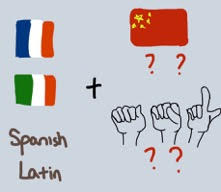A Revolution of Languages: Mandarin Chinese and American Sign Language

Art credits to Lily Yang!
February 22, 2016
No matter where you turn, there’s always that one frantic student speaking in another language. In the 200 wing, French students rapidly rehearse their dialogues as they try to memorize one last word. In the 700 wing, Spanish students struggle to stay afloat amongst thousands of supersonic dialects flying at their faces. In the 500 wing, Latin students mutter their recitations over and over again until they want to stab Caesar themselves. And the Italian and Japanese students? They’re just an enigmatic species, rarely found in the jungle of crazed language students.
However, you haven’t seen anything yet. Starting next year, American Sign Language (ASL) and Mandarin will also inhabit the jungle. Proposing that Basking Ridge needs to provide more influential language offerings, Katherine Stotler, Supervisor of World Languages at Ridge High School, introduced Mandarin and American Sign Language as two new language selections at Ridge High School and William Annin Middle School.
According to Stotler, Mandarin Chinese is the most popular spoken language in the world, and “teaches you to arrange your thoughts in a different order.” Currently, China holds the second strongest economy, and is one of America’s biggest trading partners. Thus, for students interested in business, understanding and speaking Mandarin Chinese brings lots of advantages.
As Alex Wang ’16 affirms, “Chinese companies are growing and if one is interested in jobs within the military such as service academies and the ROTC programs, Chinese speakers are in high demand.” According to Wang, Mandarin Chinese will be a huge asset to Ridge High School students.
However, Jen Huang ’18 believes otherwise: “I think it’s great that Ridge expands past the traditionally taught languages and helps students experience other cultures. On the other hand, literally every Chinese kid goes to Chinese school.”
Although Chinese school is popular, it is almost exclusive to Chinese students. Without connections, Chinese schools are hard to find. Furthermore, several students who may want to learn Mandarin Chinese, but don’t have the time to go to Chinese school now have the opportunity to take Mandarin as a class at Ridge for free. By attending Mandarin Chinese as a class at Ridge, students will also receive academic credit, which provides an incentive for those already interested in learning the language.
On the other hand, American Sign Language (ASL) is, for some, even more beneficial than learning Mandarin Chinese. After the American Disabilities Act, which required hospitals and agencies to effectively communicate with their patients, was passed in order to discourage discrimination against those with visual, hearing, or other disabilities, many students interested in health care have been rushing to learn ASL. Learning ASL may also be a positive personal experience if you want to communicate effectively with a relative, friend, or acquaintance with hearing disabilities.
However, the ASL will only be offered as a two-year course as a Level I and Level II course. There are no Honors or AP ASL courses, which may deter interested students. Moreover, after a student finishes two years of ASL, there are no more courses to take; thus, the student has to start learning a new language all over again. This could be problematic because although students are able to fulfill the Ridge High School language requirement, several colleges—from Johns Hopkins University to Villanova University—require or recommend that students take more than two years of the same language.
While Mandarin Chinese and American Sign Language are ideal language offerings, if ASL is offered as a language course at Ridge, it will need to expand and hopefully will do so in the future.



Katherine Stotler • Apr 26, 2016 at 9:19 am
Thank you so much for featuring the WL department. You did a great job highlighting different aspects of our program. As an update, unfortunately there was not enough enrollment to run Mandarin. However we will be offering ASL. Should the population of students enrolled continue to grow, the district will consider expanding to upper levels and perhaps honors.
Susan Star • Feb 29, 2016 at 1:43 pm
This article really captivates the audience and the importance of languages intermixed with education. As someone who is extremely interested in talking Sign Language, the article really informed me of my choices for next year. It’s cool how different languages are interpreted in different ways.
JasmineMathai • Feb 29, 2016 at 1:39 pm
I think this article makes a really good point, it talks about how the different languages get people to think about things in a different way. The way the article is structured is great and the writing really opens your mind to new ideas. Thanks for running this, and I look forward to reading more of them.
nastassja • Feb 29, 2016 at 1:23 pm
Although the introduction of these languages is important, we must also consider administering exams for other languages besides these ones to save students and their parents time and resources